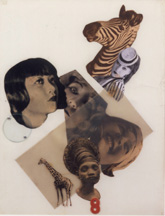Tempo, Tempo
dal 10/3/2006 al 20/5/2006
Segnalato da
Harvard University Art Museums
10/3/2006
Tempo, Tempo
Busch-Reisinger Museum, Cambridge
The Bauhaus Photomontages of Marianne Brandt

The Bauhaus Photomontages of Marianne Brandt
Tempo, Tempo! The Bauhaus Photomontages of Marianne Brandt, a pioneering exhibition of over 30 works, will be on display at Harvard’s Busch-Reisinger Museum from March 11 through May 21, 2006. The montages, created by Brandt in the mid-1920s and early 1930s, offer visually dynamic and intriguing pictorial investigations of technology, gender roles, and entertainment culture through a medium not often associated with this artist. Although Brandt is better known for her iconic metal work designs for the Bauhaus, these works reveal an artist entirely at home in the medium of photomontage. Brandt is not known to have shown the photomontages until over 40 years after their creation, and this exhibition brings together all but a handful of them for the first time.
“This exhibition is a perfect compliment to the Busch-Reisinger Museum’s outstanding holdings of Bauhaus art and design." said Thomas W. Lentz, Elizabeth and John Moors Cabot Director of the Harvard University Art Museums. “The Busch has a commitment to exploring the richness and variety of modern German art, with a special concentration on the Bauhaus era."
Harvard University Art Museums—Tempo, Tempo! In the early 1920s, Brandt had fully completed her studies as a painter when she attended a Bauhaus exhibition; she promptly burned all of her paintings and joined the school. In 1924, she became the only woman to apprentice and complete studies at the Metal Workshop. She went on to create signature metal works, including teapots, ashtrays, and bowls, that would become icons of Modernist design. After moving to Paris in 1926, she began to work intensely in photomontage, a medium that has increasingly come to be seen as quintessentially modern.
Brandt created the photomontages using fragments of popular and media culture, drawing upon the vast array of visual material made available by the period’s burgeoning illustrated press. The works explore and critique a moment of great changes in German culture and society, one in which dramatic shifts were taking place, including the advent of Germany’s first parliamentary democracy, the Weimar Republic, and the granting of suffrage to women. The montages may have been intensely personal reflections, but they also use the mass media imagery of the time to comment on key social issues. Many of the works display and investigate the rise of the New Woman, a figure seen to embody the free spirit of the time, and explore themes of freedom, judgment, and limits placed upon women by male figures around them. Other works focus on varied images of men—boxers, business tycoons, imperialists or soldiers—to represent and indicate the problematic links between manhood, aggression, and militarism in the wake of the First World War.
The exhibition was organized by Elizabeth Otto, assistant professor of art history at the State University of New York at Buffalo, for the Bauhaus Archive in Berlin and was coordinated at the Harvard University Art Museums by Peter Nisbet, Daimler-Benz Curator of the Busch- Reisinger Museum. Otto based the exhibition on her PhD research, in which she uncovered a great deal of new information about the photomontages including the existence of works that were thought to be lost.
Busch-Reisinger Museum, Harvard
32 Quincy St., Cambridge, MA 02138
Cambridge, MA, USA United States of America
Monday through Saturday from 10:00 a.m. to 5:00 p.m.
Sunday from 1:00 p.m. to 5:00 p.m.



